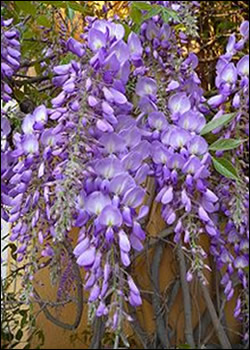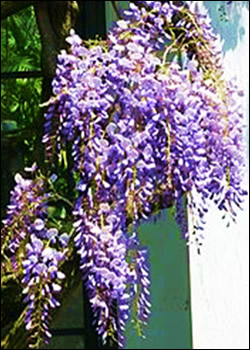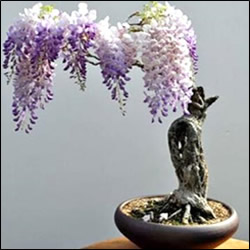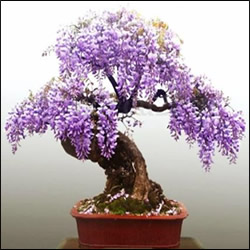Wisteria sinensis, commonly known as the Chinese wisteria, is a species of flowering plant in the pea family, native to China. Growing to 20 – 30 m, it is a deciduous vine. It is widely cultivated in temperate regions for its twisting stems and masses of scented flowers in spring, forming hanging racemes. It has shorter racemes than Wisteria floribunda (Japanese wisteria), but has a larger number of them. Japanese wisteria prefers moist soils and full sun and it is hardy in the ground. The plant often lives over fifty years.

Chinese wisteria is more sensitive to cold than Japanese wisteria

Wisteria floribunda – the Japanese wisteria is also a species of flowering plant in the pea family Fabaceae, native to Japan, and can grow to 9 m.
Wisteria trees have vine-like tendencies, but with thicker trunks. The trees grow vigorously and the branches climb and curve, from which the blooms will hang when they appear in the spring. The blooms are fragrant and are usually blue/ lavender or white in colour. The leaves are fairly small and pinnate in structure and green in colour.
Wisteria as bonsai
- They prefer to be positioned in full-sun or part-sun but do need to be protected from strong winds when grown in pots as they do not like to dry out. Wisteria bonsai need a great deal of water when growing, especially just before and during flowering. Ideally, the pot could be set in a tray of water, allowing the tree to take in all the water that it needs via its roots during flowering.
- Wisterias are vigorous growers and need heavy feeding. Nevertheless, the tree should be fed with a fertilizer that is low in nitrogen because wisteria uses nitrogen from the atmosphere, and an excess of it will promote foliar growth at the expense of flowers. Use a fertilizer that is made specifically for wisterias, and follow the feeding guidelines.
- Wisteria should receive annual pruning in the autumn. Hard pruning should only be carried out when no blooms are on the tree. Cut away all the shoots that will not be needed as branches. The object of pruning is generally to create or maintain a weeping or cascading habit, which is ideal for displaying the flowers when they are in bloom. For more abundant blooms, remove the seed pods as soon as they appear so that growth will be diverted to the flowers, and not to the development of seeds.
- Re-pot immature trees once a year, either in the early part of spring or in autumn. The roots should be teased out and pruned. More mature trees should be re-potted every two years. Wisterias perform best when planted in wide, deep pots, and using of fresh soil each time re-potting occurs will minimize the risk of disease. Wiring should only be done after blooming has finished.
Wisterias trees will not bloom until they are at least 10-years-old. The wisteria seed pods and seed are highly toxic if eaten.
Wisteria bonsai are usually of medium or large size because the long flowers need some height to hang from. Wisterias are very well suited for bonsai but their special feature is the flowers. After flowering the trunk and branches are hidden under long leaves.
It is a frost-hardy plant when grown in the ground, but unfortunately wisteria has relatively fragile roots when it is grown in a container, so it does require winter protection.
Japanese wisteria



Chinese wisteria
